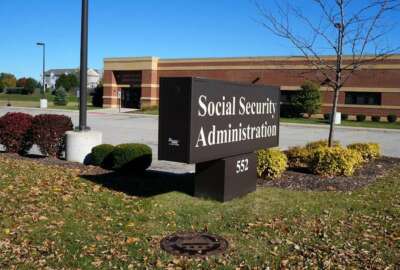SSA to open offices to the public as agency staffing issues continue
As the Social Security Administration works through ongoing recruitment and retention challenges, agency employees prepare to start in-person services on April 7.
Amid a struggle to hire more employees at the Social Security Administration, agency workers are ramping up to provide in-person services at local offices. That will start on April 7, just about a week after many of those workers returned to the office themselves on March 30.
Along with hiring issues, the agency faces problems with its phone system for customers. That could place additional strain on current employees when the agency starts in-person services, representatives from the American Federation of Government Employees said.
“We have been transparent with our employees and the public about telephone problems, which we are working hard to resolve,” SSA said in an email to Federal News Network.
Inadequate funding under the fiscal 2022 budget exacerbates the hiring and retention challenges, SSA added.
The appropriations are “not sufficient to provide the level of service the public requires, as our funding has remained relatively flat for the previous four years,” SSA said. “The 2022 enacted level is nearly $850 million short of the president’s fiscal 2022 budget.”
The agency said the flat budget contributes to staffing challenges that delay results at the customer end.
“It will require us to delay needed hires, including teleservice center staff and information technology improvements,” SSA said. “We will have less overtime available to help address increased demand from people returning to our offices for in-person service.”
The agency announced in a blog post on April 4 that it will open its doors to the public on April 7. SSA employees returned to the office last week after the agency reached an agreement with its three unions in January about return-to-office plans.
With reentry plans underway, representatives from AFGE said they’re concerned that SSA did not implement some of the union’s recommendations about how to move forward with employee telework options.
Angela Digeronimo, regional vice president for AFGE Council 220, told Federal News Network that recruitment and retention challenges for the agency are not new. In part to help alleviate those issues, AFGE recommended maximizing telework. But, AFGE said that the agency implemented a more limited telework policy.
“We are severely understaffed and we don’t have enough people to actually do the work. And this hasn’t just been happening now. This has been happening for over a decade, where now we are in crisis mode as far as staffing is concerned. But by leveraging telework, you would be able to increase your staff and not have to increase your brick-and-mortar space,” she said.
Regarding current SSA workers, the agency said employee reentry last week went smoothly.
“We provided our employees with ample notice of the re-entry date and a week to acclimate before welcoming the public back on April 7,” SSA said.
But reopening offices to the public could put additional pressure on SSA to deliver to customers, AFGE said.
To ease some of the strain, the union recommended only allowing scheduled appointments in person. Ralph de Juliis, president of AFGE Council 220, which represents about 27,000 SSA field office and teleservice center employees, said that the agency rejected AFGE’s recommendation to keep services to appointment-only, and will allow walk-ins as well.
Digeronimo added that the agency’s decision to include walk-ins in reopening plans will worsen recruitment and retention problems.
In turn, those hiring issues “will result in even longer wait times and poor service to the most vulnerable of our society, the elderly and the disabled,” Digeronimo said in a statement to Federal News Network.
The agency, however, said that it carefully thought out its plans to reinstate in-person services.
“It is critical that we restore in-person services in our offices to ensure access to our programs,” SSA said. “We have thoughtfully planned and prepared for reentry.”
Many SSA employees supported that claim, according to a survey from the agency’s inspector general office.
“The majority [of employees surveyed] believed management provided sufficient time before going back into the office and believed it was necessary to go into the office to perform certain workloads,” the IG said in a report on employee and visitor safety, updated on Feb. 24.
SSA also cited its workplace safety plan, which it updated on March 30 when employees began returning to in-person spaces. The newest version of the plan details safety precautions that align with unions’ negotiations with the agency about returning employees to the office.
“This update is being implemented upon satisfaction of applicable labor obligations with labor unions representing our employees,” SSA said in the plan. “We respect the important role of our labor unions and are committed to communicating regularly with employee representatives on workplace safety matters.”
SSA said that its negotiations with AFGE, as well as the National Treasury Employees Union and the Association of Administrative Law Judges went smoothly.
“Social Security did bargain our reentry plan with all three of our unions and reached signed agreements with all three. Our AFGE reentry agreement was heralded by the AFGE general committee spokesperson as an agreement that would save lives. We worked positively with all three unions for a safe and effective reentry.”
But AFGE representatives said they had some ongoing concerns about the way SSA is re-opening local offices. Along with including walk-ins for SSA reentry plans, de Juliis said the agency’s phone system needs to be updated.
“SSA announced on its website that if people call, they will often be disconnected. They were told not to call back. After two years, SSA still doesn’t have a fix,” de Juliis said.
The phone system issues compound what the union expects will be delays once doors open to the public on April 7. Digeronimo said issues with the phone system software, plus working with in-person customers, will create further challenges for SSA employees.
“The phone system is probably one of our biggest challenges. It’s been a challenge throughout the evacuation period. And we don’t foresee really a lot of relief once we re-open,” Digeronimo said.
The agency said it’s in the process of working through its phone system issues. It plans to evaluate changes over the next six months to determine where to adjust funding and resources.
“During re-entry, we will be operating with increased telework for field office staff, and we will be evaluating these changes over the next six months. We are closely monitoring re-entry and will shift resources, as necessary, to ensure adequate service levels,” SSA said.
As part of reopening plans, and in accordance with union agreements, SSA said it will enforce safety requirements for all in-person work spaces.
“We are continuing to require certain safety measures including masking, physical distancing, and self-health checks for COVID-19 symptoms,” SSA said.
“The health and safety of the employees, their families and the public has been, throughout the pandemic and through the process of discussing reentry with the agency, first and foremost on our mind,” Digeronimo added.
The agency will undergo a six-month evaluation period to determine changes to return-to-office versus telework plans. That evaluation will end in late September.
Copyright © 2024 Federal News Network. All rights reserved. This website is not intended for users located within the European Economic Area.
Drew Friedman is a workforce, pay and benefits reporter for Federal News Network.
Follow @dfriedmanWFED






